November 30, 2021 – Volume 23, Issue 11
In This Issue
- Flanigan’s Eco-Logic: COP 26 Thanks
- Setting the Bar Higher on Renewables
- Carbon Removal XPrize
- Microgrid Utility Synergy
- Organic Foods
- Big-Time Floatovoltaics
- Sustainable Vacations
- The NetPositive Podcast Updates

Flanigan’s Eco-Logic: COP 26 Thanks
A shout-out to all those that participated in the COP26 meetings in Glasgow. Thank you for your efforts as global citizens on behalf of the state of the planet. While some of us are intrigued, some disgusted, others exasperated… the COPs are critical. The climate crisis needs to be fully acknowledged and addressed in all political, social, faith-based, academic, and economic realms.

The time has come. While international negotiations on climate commitments are painfully slow, they provide an essential foundation. Without question, there is much work needed… and fast. There’s much work to be done at the policy level and even more in terms of implementation. The COPs provide a framework for action. In his closing session remarks, John Kerry, the U.S. Special Presidential Envoy on Climate, noted that “Paris built the arena. Glasgow starts the race.”
The COPs are painfully incremental. Craig Ebert discusses his impressions of COP26 in the latest episode of The NetPositive Podcast. It was his 13th COP. He went to Glasgow prepared for a lot of not much. He reminisces about his naive and idealistic sentiments post Kyoto, COP3. He thought that was the beginning of the end of the climate crisis. At best, he thinks that now COP26 may be the end of the beginning. But just now, and after many, many COPs… Craig and others report that finally there is a clear consensus at the COP that there is a problem that needs to be addressed. There is no question any more of the reality of the crisis.
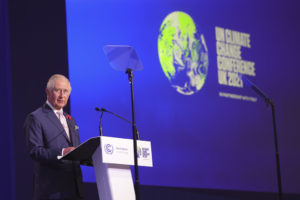
There was talk of deeper commitments, and new commitments to cut use of coal, to slash methane emissions and forest deforestation. A GOP congressional delegation made a COP appearance for the first time. The Conservative Climate Caucus was created by U.S. Representative John Curtis in June, and now numbers 70 members of the 213 House Republicans. The congressmen were brought by the right-wing advocacy group called Citizens for Responsible Energy Solutions. While members of the caucus have poor environmental voting track records, the caucus is doing important work helping the Republican party catch up with the rest of the world.
Greta Thunberg’s scowl is memorable. She’s been a profound force… a sharp rallying cry for her generation. She makes clear that climate denial and inaction is crazy. We are not doing enough. Craig reflects that the younger generation is pissed; there’s an overwhelming sense of frustration. Greta calls the chatter the “blah, blah” factor. A Facebook posting: “Goals, commitments, pledges, and net zero targets are not action.” Why bring together 30,000 people for more talk and no action? To many, COP26 was not a success. Some said that at best it “kicked the can down the road.”

I hear that. There was clearly lots of hot air accented by lots of political pledges ready to be unfulfilled, but there is a consensus of the need for accelerated action. COP26 was steeped in a much greater focus on 2030, and the immediacy of the climate crisis. We cannot think in terms of progress by 2050… that’s too distant. There were other exciting developments in Glasgow such as establishing a trillion dollar fund to support developing nations.
Metrus Energy CEO Bob Hinkle attended and wrote that the “private sector — at least at the board level or C-suite — is setting the pace. Fortune 1000 firms, banks, insurers, and investors were out en masse in Glasgow.” A financing coalition was established by a former governor of the Bank of England representing $130 trillion in assets. They are pledging to no longer lend capital for fossil fuels. And yes, the parties agreed to reassemble next year in Egypt for COP27.
Quote of the Week
“I am here [in Glasgow] to show the world that Republicans also care about climate change. We have not been as vocal as we should be and I want to change that.”
Setting the Bar Higher on Renewables
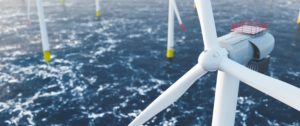 No doubt about it, the pace of adoption of renewable energy is brisk. Wind, solar, geothermal, wave, tidal, and more. More and more pledges of carbon neutrality, net zero carbon… 100% solutions. But now the bar is being set even higher: 24/7 renewables, what some call 24/7 CFE (carbon-free energy). Thus we usher in a new utility system planning paradigm.. the art of precisely matching renewables — real-time and stored — with demand.
No doubt about it, the pace of adoption of renewable energy is brisk. Wind, solar, geothermal, wave, tidal, and more. More and more pledges of carbon neutrality, net zero carbon… 100% solutions. But now the bar is being set even higher: 24/7 renewables, what some call 24/7 CFE (carbon-free energy). Thus we usher in a new utility system planning paradigm.. the art of precisely matching renewables — real-time and stored — with demand.
Calculating renewable generation on an annual basis isn’t sufficient. To make renewables truly effective decarbonization tools, their output must be matched with our consumption patterns. What does that mean? It means that for every hour of the day, every moment in time, that the power being delivered is renewable, or has been renewably generated and stored.
In the popular net zero environment, where you may be paying for 100% renewable power, there are times of the day when you are actually getting electrons powered by fossil fuels. The grid still relies on coal, gas, and oil. We rely on coal, gas, and oil for certain times of the day and year.
Think of your own home, or mine. You put up solar panels and wipe out your electricity consumption from the grid, say 14,000 kWh a year. Only when the sun shines, however, are you actually getting green electrons and sending excess to the grid for credit. At night, you may well be drawing upon coal, gas, or nuclear.
The push to 24/7 is a bit daunting. But fear not. If we entertain a grid made up of a nice mix of renewables — wind, solar, geothermal, hydro, tidal/wave, biomass, etc. — buttressed with storage, we can achieve the 24/7 goal. Coastal wind is strongest in the morning and late afternoon. Intercontinental wind is strongest at night. Offshore wind blows all the time. Burlington, Vermont owns and operates the 70 MW Intervale woodchip plant that can run baseload. Some renewables are baseload, others are intermittent.
Want to set the bar even higher? Sure. Well then let’s add energy resilience to the equation, and beyond that equity. We strive for all to have access to clean and reliable power — backed up with microgrid networks — that is truly clean all the time. This is taking the Renewable Portfolio Standard to a higher level. It’s pushing well beyond carbon offsetting and greenwashing… the industry practice of making fossils clean through purchase of RECs. The 100% clean claim is false. In actuality, some of the power — perhaps 25% of the time in California — consumed is fossil-fuel derived.
Around the clock green is a new theme among leading corporations committed to aggressively battling climate change. This is about being green on an hourly basis. More than 100 global companies have joined the Energy Tag initiative. Google and Microsoft have enabled their data centers to become more sustainable through hourly monitoring and matching with carbon-free sources from their clean energy portfolios. They are addressing the inherent intermittency of renewables, and filling in the gaps with carbon-free energy and storage.
Carbon Removal XPrize
 This is cool in my book: Fully 23 student teams are getting cash infusions for their carbon-removal ideas. The Carbon Removal XPrize is focused on fostering innovative ways of taking CO2 out of the atmosphere. Several teams have suggested solutions that solve more than the CO2 issue at the same time. Some, frankly, are chemically complex and over my head.
This is cool in my book: Fully 23 student teams are getting cash infusions for their carbon-removal ideas. The Carbon Removal XPrize is focused on fostering innovative ways of taking CO2 out of the atmosphere. Several teams have suggested solutions that solve more than the CO2 issue at the same time. Some, frankly, are chemically complex and over my head.
The intent of the $100 million Carbon Removal XPrize is to remove CO2 from the air and ocean. It’s funded by Tesla and SpaceX CEO, Elon Musk. The awarded teams have four years to demonstrate their carbon capture method and means of storing CO2 safely for a minimum of 100 years. Eighteen select teams were given $250,000 each to continue developing their technologies with the opportunity to compete in later competition stages. Five others were awarded $100,000 each. Let’s dive into a few:
Using old oil rigs as seaweed farms is the project of the Blue Symbiosis team from Australia’s University of Tasmania. Its team envisions repurposing oil and gas rigs as regenerative farming sites. One end use for the seaweed is as an ingredient in construction materials such as fire resilient bricks. This enables carbon to be stored and quantified.
University of Toronto students have devised a means to make DAC (Direct Air Capture of CO2) 16% more efficient. The E-quester team is using a novel “electrochemical regeneration system” that recycles captured CO2 to help power the filtration process.
Meanwhile, the Acid Project from the University of Miami is taking on ocean acidification. Students there are using green hydroxide. It’s a low-carbon form of alkalinity made from mining waste products and water using renewable electricity. The green hydroxide is added to the oceans to reduce acidity. “Like a big Alka Seltzer,” says a student leader.
Microgrid Utility Synergy
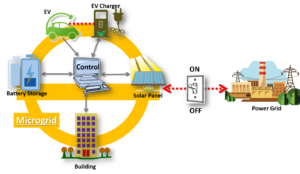
Image Courtesy of Smart Grid Center, Texas A&M Engineering Experiment Station (TEES)
Microgrids are understandably popular these days. Customers want resilience. You’re a supermarket, a restaurant, or a cold storage facility and you want to be able to operate if the grid goes down. This is often an expensive proposition. Much of EcoMotion’s work involves tapping into the “stacked the benefits” of storage systems. It’s about finding multiple revenue streams for costly batteries whose primary purpose is energy resiliency. It’s about synergy in microgrid functionality.
Now microgrids in California will be earning money by supporting utilities in times of emergency. Microgrids can now generate revenues by sending power to the grids during periods of utility system stress. This helps to amortize expensive battery costs.
The Marine Corp Air Station Miramar signed a deal with San Diego Gas and Electric. The base will provide power from September and October to help avert emergencies. Specifically, and in an agreement called the Summer Generation Availability Incentive, Miramar can provide SDG&E with 6 MW up to five times a month, between 4 and 9 PM during weekdays in September and October.
How did this come about? During the Summer of 2020, and during a period of high demand caused by the heat wave, Miramar provided emergency power to the grid and was not compensated for it. Ohm Connect, a demand response provider, was also not compensated for 200 MWh of load that it contributed to the grid in this time of crisis. As such, the CPUC created two new programs to address system stress spurred by heat waves: The Electric Load Reliability Program and the California State Emergency Program which provide $1,000 and $2,000/MWh respectively for customer onsite generation during periods of extreme system stress. Diesel generators are currently eligible to participate; the Miramar microgrid is 50% renewable and 50% diesel.
Organic Foods
 The United States is the number one organic nation in the world. We have the biggest appetite for organics… worth some $58 billion a year right now. And yet, the United States has less than 1% of its total U.S. agricultural land in organic production. That’s 5.6 million acres farmed to the national organic standard. Compare that with 16 countries that have over 10% of their ag lands in organic production. Like Sweden 20.4%, Austria 26.1%, and the leader Lichtenstein 41%. There are 343,858 organic farmers in the EU, and 16,585 in the US. Meanwhile, the annual per capita organic spending is $152.32 in the US and $94.08 in the EU. The result is that the U.S. imports organic goods from 45,000 foreign operations.
The United States is the number one organic nation in the world. We have the biggest appetite for organics… worth some $58 billion a year right now. And yet, the United States has less than 1% of its total U.S. agricultural land in organic production. That’s 5.6 million acres farmed to the national organic standard. Compare that with 16 countries that have over 10% of their ag lands in organic production. Like Sweden 20.4%, Austria 26.1%, and the leader Lichtenstein 41%. There are 343,858 organic farmers in the EU, and 16,585 in the US. Meanwhile, the annual per capita organic spending is $152.32 in the US and $94.08 in the EU. The result is that the U.S. imports organic goods from 45,000 foreign operations.
Organic is part of the climate solution. Agriculture emits over 600 million metric tonnes of CO2e each year… more than the annual emissions of the United Kingdom. Organic food production generates fewer greenhouse gas emissions than conventional farming largely because it does not use synthetic nitrogen fertilizer. It also prohibits using synthetic pesticides and giving hormones or antibiotics to livestock.
Europe with a $46 billion organic appetite, has a far more aggressive approach to organics. The European Union has a “Farm to Fork” program considered the heart of the European Green Deal. Its goal is to cut ag emissions by 50%, to use 50% less pesticides and 20% less fertilizer. The EU’s goal is to increase organic ag land from 8.1% to 25% by 2030. There is a detailed organic plan to achieve this goal established by the European Parliament.

Beyond the health benefits for those who eat organic food, organic farming has five key benefits: It reduces exposure to harmful chemicals for both farmers, birds, and animals. It consumes less energy. It reduces nitrogen runoff-induced pollution. It facilitates healthy soil formation, and it combats the effects of global warming. The British Department for Environment, Food and Rural Affairs reports that organic crops and organic dairying use 35% and 74% less energy than their conventionally grown counterparts.
There are now “regenerative turkeys.” Cream Co is known to be the first California farm to raise regenerative turkeys. Its ranches are managed to form and maintain sustainable ecosystems. This involves feeding turkeys with native grasses. The birds are raised without the need for antibiotics, hormones, GMOs, or additives. They are free range and as such are not subject to unsanitary and overcrowded living conditions. The farms focus on soil health, they practice rotational, multi-species grazing, cover cropping, no-till farming, and compost application.
Big-Time Floatovoltaics
The dam at Ubon Ratchathani, Thailand was built from 1968 – 1971 to supply power and water for irrigation. Located 410 miles east of Bangkok in the Mekong River Basin, it is the region’s largest water supply. The three 12 MW generators in the Sirindhorn Dam there generate 90 GWh annually.
Now the site on the Lam Dom Noi River is home to the world’s largest floating photovoltaic plant. There are 145,000 solar panels mounted on floating platforms. The ~$25 million floatovoltaic system includes seven sets of solar cell panels, a concrete underwater anchoring system, and a switchgear building. High density polyethylene was used for buoys and other equipment to protect aquatic animals. The solar panels are the double-glass type, able to withstand splashing water. The local government plans to make the floatovoltaic plant a tourist attraction open to visitors in 2022.
Some say that floating solar has “taken off” in the past few years. There are systems in more than 40 countries around the world. Much of this has been systems installed on lakes created by dams. Calm waters are a good fit. A National Renewable Energy Laboratory (NREL) study identified a global potential for floatovoltaics of 7.6 terawatts. That impressive potential is increased by a factor of at least 7 when the technology is deployed in oceans and large lakes. The Netherlands has analyzed and reported an offshore solar potential of 45 gigawatts.
Floatovoltaics make sense in areas with limited land availability, they feature “no land consumption.” While solar panels are inherently waterproof, floatovoltaics can come at a cost premium. On the other hand, placing solar panels over water has a cooling effect on the panels, which in turn leads to greater PV production, 10 – 15% greater output than similar land-based systems. While the Sirindhorn Dam solar field covers less than 1% of the entire reservoir’s water area, by covering water surface area with panels, there is a reduction in water evaporation. In this case the reduction of water through evaporation is 460,000 cubic meters per year.
Thailand has a national goal of being carbon free by 2065. The country pledged in Glasgow to accelerate this to 2050. This floatovoltaics project will lower emissions by 47,000 tons per year. According to the Bangkok Post, the project is being developed by the B.Grimm Power – Energy China consortium on behalf of the Electricity Generating Authority of Thailand (EGAT). It is the first of 16 projects planned by EGAT for 2.7 GW of total capacity.
Now here’s a twist… the Swiss Army knife of renewable energy. An offshore system that combines solar, wind, and wave power. The German company, SINN Power, has developed a floating hybrid renewable energy platform that does this. It has been testing the platform in the Greek port of Iraklio since 2015. Now it has introduced its seafaring platform, called the Ocean Hybrid Platform. Transferring freshwater solar fields to ocean environments – to seawater floating PV — certainly has its challenges including hostile and large waves, tough freezing conditions, etc. The Ocean Hybrid Platform is designed for wave heights up to 12 meters.
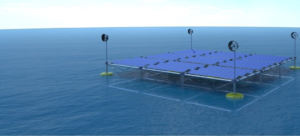
Image Courtesy of Hydro Review
Sustainable Vacations
 Well this news item caught my attention… sustainable vacations. Sounds really good. But what does that mean? Do you visit a region or a resort that is sustainable? If you travel halfway around the world to visit it, is that sustainable? The travel alone racks up a lot of greenhouse gas emissions… an indulgence even with offsets.
Well this news item caught my attention… sustainable vacations. Sounds really good. But what does that mean? Do you visit a region or a resort that is sustainable? If you travel halfway around the world to visit it, is that sustainable? The travel alone racks up a lot of greenhouse gas emissions… an indulgence even with offsets.
The article that tipped me off to “sustainable vacations” was about a resort in Washington State near Mount Baker. Called the Oculis Mountain Side, it is an eco-friendly community of year-round domes, “fabulously appointed alternative accommodations.” When complete, there will be a community of 50 domes circling a pool. It’s a hybrid, the best of glamping, vacation rentals, and hotels. There, “you retire to a private vacation dome tucked into a forest of pine trees with a huge skylight that lets you stargaze from your bed….” Looks kinda nice! The domes are fabricated by shooting concrete over an airform. There are one and two bedroom suites made with the most sustainable materials. They use 50% less energy than typical structures.
A little Googling resulted in seven parameters of sustainable vacations:
- Choose a destination that values sustainability
- Consider how you get there
- Book eco-conscious accommodations
- Support local economies, and opt for sustainable activities
- Reduce food and plastic waste
- Limit energy use and conserve water
- Leave a place better than you found it
In the United States, aviation represents 9% of annual transportation emissions and thus 3% of total GHG emissions. Globally, aviation produced 2.4% of total CO2 emissions in 2018. I’ve been lucky to visit Copenhagen, Denmark several times. It’s considered one of the world’s greenest cities. I’ve also visited New Zealand, one of the world’s greenest countries. Getting there, however, was anything but sustainable!
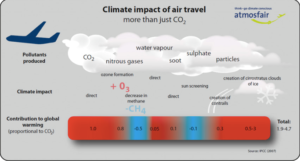
Image Courtesy of Atmosfair
Let’s bring this down to earth and a single roundtrip to the East Coast. That’s about 5,000 miles. Aircraft emit 90 grams of C02 per revenue passenger kilometer, or 150 grams/revenue passenger mile. Thus 5,000 miles or air travel results in 750,000 grams of CO2… or three-quarters of a tonne of CO2! The average Californian emits a tonne a month… so adding air travel can easily double one’s monthly footprint. According to the German non-profit Atmosfair, flying round-trip from London and New York generates about 986,000 grams of CO2 per passenger. Nearly a tonne of CO2 to propel a vacation.
The European Environment Agency reports on relative GHG emissions intensity of different modes of transport. Trains are most efficient at 14 grams of CO2 per passenger kilometer. Then cars: Small cars emit 42 grams/km (and three times that if stuck in traffic). Normal cars loaded with four people emit 55 grams/km. And add 7-20% more CO2 if AC on! Those values compare to 285 grams/passenger kilometer for aviation.
The NetPositive Podcast Updates
Recently Released:
- This issue of EcoNet News, Volume 23, Issue #11 is also available in podcast format
- The NetPositive Podcast: A Conversation with Craig Ebert, Executive Director, Climate Action Reserve
Live “Crash Courses” with Ted Flanigan Hosted by Sierra Flanigan:
- The NetPositive Podcast: Live Crash Course on Vehicle-to-Grid technology with Ted Flanigan, hosted by Sierra Flanigan

Check out and subscribe to The NetPositive Podcast with Ted Flanigan on Spotify, Apple, and Google. Episodes include Convos (Conservations and Crash Courses), the News (EcoNet News), and Uni (the EcoMotion University).
